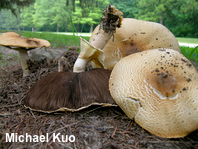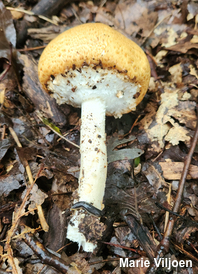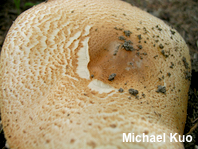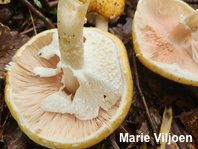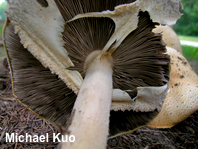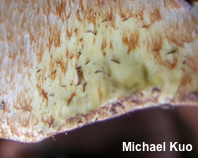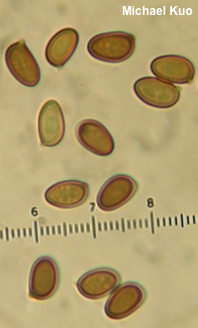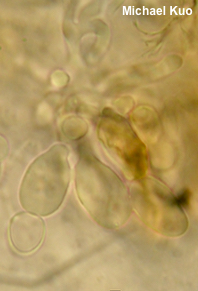| Major Groups > Gilled Mushrooms > Dark-Spored > Agaricus > Agaricus nanaugustus |

|
[ Basidiomycota > Agaricales > Agaricaceae > Agaricus . . . ] Agaricus nanaugustus by Michael Kuo, 30 March 2024 This attractive Agaricus is eastern North America's version of the West Coast's Agaricus augustus and the Rocky Mountain version, Agaricus julius. All three mushrooms are characterized by large size, strong almond odor, and scaly brown caps. Range is the best way to separate the three species, but if you are bound and determined to pretend you are aboard the Enterprise and collections have just been transported to you from Earth with no cited locations, augustus and julius are usually more brown, while nanaugustus is brownish orange, becoming orangish brown; then, between the two emperors, augustus has slightly larger spores and a blockier young cap. Thanks to Marie Viljoen for documenting, collecting, and preserving Agaricus nanaugustus for study; her collection is deposited in The Herbarium of Michael Kuo. Description: Ecology: Saprobic; growing gregariously under Norway spruce, blue spruce, and other trees, including oaks, primarily in urban settings; summer and fall; originally described from Pennsylvania (Kerrigan 2016); possibly distributed throughout eastern North America. The illustrated and described collections are from Illinois and New York. Cap: 5–19 cm; convex at first, becoming broadly convex or nearly flat; dry; when young brownish orange to orangish brown, and radially fibrillose; soon becoming scaly with orangish brown to golden brown, fibrillose scales over a pale golden or orangish surface; the margin not lined, yellowing when rubbed repeatedly. Gills: Free from the stem; close or crowded; short-gills frequent; pinkish when young, becoming dark brown with maturity; covered with a whitish, shaggy partial veil when in the button stage. Stem: 5–10 cm long; 1–2.5 cm thick; equal above a slightly swollen base; fibrillose to somewhat shaggy, especially toward the base; with a thick, rubbery, white to yellowish ring; whitish; bruising slightly reddish brown; basal mycelium white. Flesh: White; firm; unchanging when sliced, or becoming yellowish to orangish. Odor and Taste: Strong; reminiscent of almonds. Dried Specimens: Cap and stem dull orangish. Chemical Reactions: KOH yellow on cap surface. Spore Print: Dark brown. Microscopic Features: Spores: 6–8 x 4–5 µm; ellipsoid; smooth; thick-walled; brown in KOH; brown in Melzer's. Basidia 24–28 x 4–5 µm; clavate; 4-sterigmate. Pleurocystidia not found. Cheilocystidia 10–25 x 6–15 µm; mutliseptate and catenulate; terminal elements subglobose to clavate; smooth; thin-walled; orange-brown to hyaline in KOH; soon collapsing. Pileipellis a cutis; elements 5–7.5 µm wide, smooth, golden yellow or hyaline in KOH. REFERENCES: Kerrigan, 2016. Herb. Kuo 08250605 (paratype), 09292301. This site contains no information about the edibility or toxicity of mushrooms. |
© MushroomExpert.Com |
|
Cite this page as: Kuo, M. (2024, March). Agaricus nanaugustus. Retrieved from the MushroomExpert.Com Web site: http://www.mushroomexpert.com/agaricus_nanaugustus.html |
